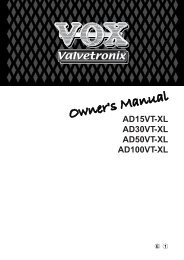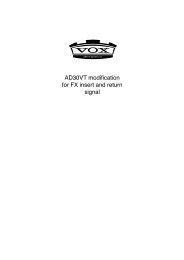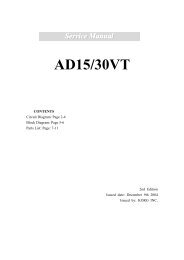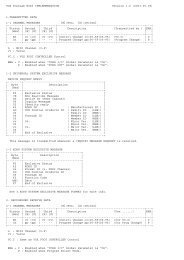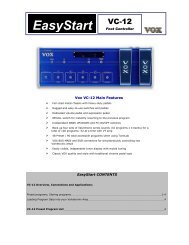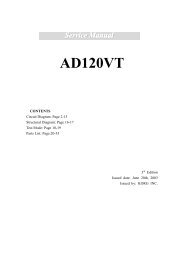ToneLab LE's manual - Vox
ToneLab LE's manual - Vox
ToneLab LE's manual - Vox
You also want an ePaper? Increase the reach of your titles
YUMPU automatically turns print PDFs into web optimized ePapers that Google loves.
VALVE REACTOR TECHNOLOGY<br />
THE POWER (AMP) AND THE GLORY!<br />
Valve Reactor technology was first used on the critically acclaimed VOX AD60/120VT<br />
Valvetronix amps.<br />
The Valve Reactor circuitry in <strong>ToneLab</strong> LE however has been tuned-up especially for<br />
live performance.<br />
Since conventional modeling effects for line recording are not used directly with a<br />
speaker, they do not include a power amp circuit, output transformer, or speaker. In other words,<br />
they only have a preamp circuit.<br />
A real valve amp sound, however, is produced not just by the preamp, but also by the tone and<br />
distortion of the power amp, and by the constant changes in impedance that are created by the<br />
power amp driving the speakers. <strong>ToneLab</strong> LE contains an actual low-wattage valve power amp<br />
circuit, a virtual output transformer that uses solid-state components to simulate an output transformer,<br />
and a dummy speaker circuit that simulates the varying impedance of a real speaker.<br />
This means that although it’s low-power, <strong>ToneLab</strong> LE has the same circuit structure of an actual<br />
all-valve amp.<br />
While much of the tone creation and shaping carried out is done in the digital domain, its<br />
Valve Reactor power amp is 100% analogue. The resulting journey your guitar’s signal takes through<br />
the analogue world of the power stage plays a major role in providing the all-important feel and tone<br />
of the original amps we modelled.<br />
The Valve Reactor power stage is, to all intents and purposes, a bona fide valve (tube) push-pull<br />
power amplifier, but in miniature. It utilizes a 12AX7 (ECC83) valve (a dual triode device — meaning<br />
“two valves in one”) and is equipped with an output transformer, like a “real” valve amp.<br />
The power amp output of <strong>ToneLab</strong> LE’s Valve Reactor is designed to “read” the constantly changing<br />
impedance curve of the dummy speaker circuit system and feed this information back to the virtual<br />
output transformer — just like real valve amplifiers do. This information permits the behavior of the<br />
valve stage of the amp to vary with the speaker load (impedance), which is another important part of<br />
“real world” valve tone.<br />
Apart from the vital valve tone this ingenious power amp design provides, it also allows us<br />
to replicate various “circuit characteristics” that are unique to the all-valve power stages of the amps<br />
we’ve modelled. These “characteristics” include: Class A or Class AB operation, Presence and<br />
Resonance (low end) control circuitry (both found in the negative feedback circuit that some, but not<br />
all, valve power amps have). Being able to match such vital characteristics helps ensure that each<br />
and every one of our models is as tonally authentic as possible — as opposed to the usual “close<br />
but definitely no cigar” norm of digital modeling. And just so you know, this patented in USA power<br />
amp technology is unique to VOX Valvetronix.<br />
VOX VALVE REACTOR<br />
PREAMP<br />
PHASE<br />
INVERTER<br />
FEEDBACK<br />
CIRCUIT<br />
(WITH OR W/O<br />
PRESENCE &<br />
RESONANCE)<br />
MODEL<br />
DEPENDENT<br />
BIAS<br />
BIAS<br />
12AX7<br />
(ECC83)<br />
12AX7<br />
(ECC83)<br />
VIRTUAL OUTPUT<br />
TRANSFORMER<br />
12AX7 (DUAL TRIODE)<br />
PUSH–PULL OUTPUT<br />
CLASS A OR AB<br />
MODEL DEPENDENT<br />
REACTOR<br />
AMP<br />
USING<br />
CONSTANT<br />
CURRENT &<br />
REACTIVE<br />
FEEDBACK<br />
DUMMY<br />
SPEAKER<br />
10




